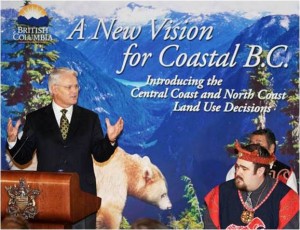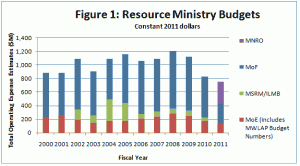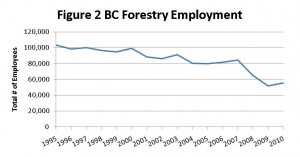Next week, after ten years as Premier of British Columbia, Gordon Campbell will hand power over to Christy Clark. Natural resource policy has been one of the most dynamic areas of policy development during the Campbell era. This blog provides an overview of the most significant policy changes during Campbell’s tenure in the areas of energy, climate and forest policy. (Other aspects of the environment portfolio are not addressed.) This overview is not intended as an evaluation of the merits of the changes, but rather a ranking of the ten most consequential developments. I also provide a list of the five most significant shortcomings in policy development during the Campbell decade.
There are some deep contradictions in the list. That is by design. Climate action and aboriginal reconciliation top both the lists of most significant changes and greatest failures. In my view, this is an apt characterization of the immense challenges of governing natural resource policy in BC during the Campbell era.
The Top Ten Natural Resource Policy Changes under Gordon Campbell
- Climate Action: The Campbell government legislated ambitious greenhouse gas reduction targets (33% reduction by 2020 over 2007 levels) and enacted ambitious policy instruments (the carbon tax, cap and trade, and government carbon neutrality) to pursue those targets. These initiatives made the province a North American leader in climate action and won Campbell kudos from the environmental community.
- The New Relationship with First Nations: Gordon Campbell entered government as a confrontational opponent of aboriginal rights, but by 2005 underwent an extraordinary conversion into a champion of Crown-aboriginal reconciliation. The effort to legislate the New Relationship crashed spectacularly into the political abyss between the resistance of Cabinet and the aspirations of the province’s First Nations. But real progress in power sharing has been made in specific reconciliation agreements between the BC government and First Nations along BC’s coast.
- The 2002 Energy Plan required that all new sources of electricity generation (other than Site C and upgrades to existing BC Hydro facilities) be developed by the private sector. Independent power producers and run of river power projects ignited outrage by the BC environmental community and public sector unions, and provoked a divisive split among environmental groups.
- The 2010 Clean Energy Act shifted the objective of electricity supply from provincial self-sufficiency to being a net exporter of power. It also strengthened BC Hydro’s conservation mandate, requiring it to meet two-thirds of new demand through conservation measures. It also punished the BC Utilities Commission for having the temerity to reject BC Hydro’s 2008 long term plan by removing many of the regulator’s powers of review of BC Hydro activities.
- The Forestry Revitalization Plan of 2003 introduced market-based stumpage pricing, reallocated 20% of the industry’s tenure, and removed a number of levers by which government controlled industry transactions within the sector. Among other things, this economic deregulation unleashed a wave of corporate consolidations that reshaped the sector.
- The Great Reorganization of 2010 separated the policy and operational functions of five ministries, and consolidated operations into a new Ministry of Natural Resource Operations. Among many other consequences, the reorganization effectively dismantled the BC Forest Service that has been in continual operation since 1912.
- The 2007 Energy Plan effectively banned new coal-fired power plants, set a bold target requiring BC Hydro to meet half of new demand through conservation, and shifted the objective of electricity policy from cost-effective reliability to provincial self sufficiency with reserves.
- The Great Bear Rainforest agreement of 2006 brought an end to a decade long land-use dispute. The decision’s increase in protected areas and more eco-friendly logging standards led Greenpeace and ForestEthics to declare victory in their campaign to save the precious wilderness area.
- Downsizing Natural Resource Agencies: The “free enterprise” element of the Campbell government has been keen to reduce the role of government in the resource sector, and it has certainly succeeded in terms of the decreased capacity of provincial resource agencies. The budgets of all the major resource agencies in 2011 were 15% below what they were when Campbell took office in 2001, and 37% below their 2006 peak (constant 2011 dollars, see Figure 1 below).
- Bill 30 – in response to the Squamish-Lillooet Regional District decision not to approve the Ashlu Creek run-of-the-river power project, the provincial government passed legislation in 2006 stripping local and regional governments of the power to use zoning processes to block new energy projects.
The Top Five Natural Resource Policy Failures under Gordon Campbell
- Climate Inaction: While promoting the climate action file with Schwarzeneggerian fervour, Campbell more quietly fostered the development of the province’s carbon-loaded natural gas resources. As a result, the real Campbell legacy on climate is one of hypocrisy, revealing the enormous challenges of the climate file even in jurisdictions blessed with abundant hydroelectric resources.
- Dismal Progress in Treaty Settlement: Despite Campbell’s 2005 conversion to champion of aboriginal reconciliation, accomplishments in reaching long term settlement with First Nations have been sparse. When Campbell came into office, no treaties had yet been proclaimed under the treaty process that began in 1991 (the Nisga’a agreement took place outside of the official treaty process). As of March 2011, only one treaty has been finalized through the process (Tsawwassen First Nation). There are seven agreements-in-principle but they have yet to be proclaimed, and an additional 41 still being negotiated.
- The Softwood Lumber Dispute was a vexing challenge when the Campbell government entered office in 2001. Despite massive changes in forest policy designed to address American concerns, tens of millions of dollars in legal fees to Washington, DC law firms, and a major new bi-national agreement, the softwood lumber dispute remains a vexing challenge as Campbell leaves office. In perspective, though, softwood lumber has been a challenging issue in US-Canada trade since before Confederation.
- Forest sector employment has taken a beating during Campbell’s tenure. Despite major policy changes designed to put the sector on competitive footing, forest sector employment has decreased 38% from 89,000 jobs in 2001 to 55,000 jobs in 2010 (See Figure 2 below). The change has been wrenching for forest-dependent communities throughout the province.
- The Working Forest has been a spectacular failure. Despite being the number one priority in their 2001 “New Era” forestry agenda, the proposal to promote commercial investment in forestry by increasing the certainty of a working forest zone crashed and burned near the end of Campbell’s first term. Struggling for policy initiatives to address the enduring crisis in the sector, the idea was reborn as the Commercial Forestry Reserve as a result of the Working Forestry Roundtable in 2009. But it has gone nowhere since being rejuvenated. Meanwhile, the Campbell government never seriously considered or proposed more serious structural reform of the province’s anachronistic system of forest tenures.
I would like to thank Stephanie Taylor for research and writing help and preparation of Resource Ministry Budget Figures, and David M. Pérez for help with employment figures.




The Clean Energy Act forces BC Hydro to have power surpluses every year, even in low-water years.
BC Hydro is forced into buying power from new IPP projects at an average of $100/MWh.
A power surplus means BC Hydro will be exporting, most likely into the U.S.
The Mid-C (NW U.S.) price for firm electricity today (Mar. 8, 2011) is $18.57/MWh.
Does this mean BC Hydro is exporting power for less than 1/5 of what it pays the IPP for it?
Isn’t that a problem?
http://www.bloomberg.com/energy/
The Mid-C price today (Mar. 10, 2011) is $9.79/MWh.
I was told that BC Hydro will pay up to $150/MWh for power from bioenergy plants in BC. This is 14 times the current Mid-C price. My understanding is that Mid-C comes from mostly clean hydro power.
Hugh’s comment on the Mid-Columbia price of electricity quoted by Bloomberg is misleading. The Mid-Columbia price represents the wholesale price of electricity for customers who are largely other utilities. The electricity is delivered at a very high voltage and the utility buying it is then responsible for any additional costs associated with supplying that energy to their own retail customers. By the time the power is actually delivered to consumers, the cost is much higher- probably in the $100 to $150/Mwh range. I submit that the current price paid to IPP’s in B.C. is much less than the cost of B.C. Hydro developing new power generation in B.C.